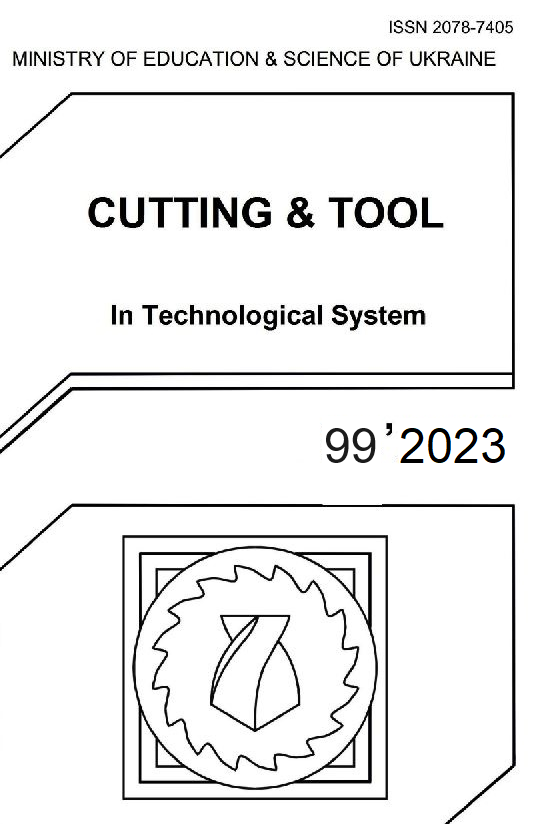ACTUAL CONTACT AREA ON THE WORN CLEARANCE FACE OF THE CUTTER WITH THE ROUND KYBORITE INSERT
DOI:
https://doi.org/10.20998/2078-7405.2023.99.08Keywords:
cutting tool, clearance face, Kyborite PCBN, contact area, irregularities, actual contact areaAbstract
For a tool equipped with a circular cutting insert, a dependence is proposed for calculating the nominal area of the contact area on the back surface. It is proved that the actual area of the contact area of the tool differs significantly from the nominal one due to the presence of a system of micro-irregularities, which makes a difference in the assessment of machining process parameters. Using the example of a tool equipped with a circular cutting insert made of polycrystalline cubic boron nitride ciborite, an approach to determining the actual contact area of the back surface with the workpiece during finishing turning of hardened steel is considered. The possibility of taking into account the influence of the system of irregularities in the contact area, determined by the parameters of its topography, on the size of the actual area is shown, and the ratio of the actual and nominal areas of the contact areas of the tool is determined, and it is found that, depending on the degree of development of the microrelief, the ratio of the actual and nominal areas of the contact surface of the cutter differs by at least 20%. It is shown that the actual contact area is also related to the total length of the main and auxiliary cutting edges, determined by the maximum values of the main and auxiliary angles in the cutter plan, and the size of the wear chamfer on the back surface of the cutter.
References
Poletyka M. F. Kontaktnye nahruzhky na rezhushchykh poverkhnostiakh ynstrumenta. – M. : Mashynostroenye, 1969. – 148 p.[in Russian];
Rozenberg Yu. А. Rеzanie materialov : uchebnik dlja VUZov. – Kurgan : Izd. ОАО Poligraf k-t», Zaural’e, 2007. – 294 p.;
Vysokoproyzvodytelnaia chystovaia lezvyinaia obrabotka detalei yz stalei vysokoi tverdosty / S. A. Klymenko, A. S. Manokhyn, M. Yu. Kopeikina i dr.. – Kyiv : ISM im. V. N. Bakulia NAN Ukrainy, 2018. – 304 p.;
Demkyn N. B., Ryzhov E. V. Kachestvo poverkhnosty y kontakt detalei mashyn. – M. : Mashynostroenye, 1981. – 244 p.;
Тehnologicheskoe obespechenie i povyshenie ekspluatatsyonnyh svoystv detaley mashin i soedinenii / A. G. Suslov, V. P. Fedorov, O. A. Gorlenko i dr. – М. : Mashynostroenye, 2006. – 448 p.;
Bogdanovich P. N., Pryshak V. Ja., Bogdanovich S. P. Trenie, smaska i iznos v mashinah : uchebnik dlja VUZov. – Minsk : Tehnologija, 2011. – 527 p.;
Manovytsky A. S., Klymenko S. An., Kopeikina M. Yu. Opredelenye ploshchady zadnei poverkhnosty yznosa reztsa yz PKNB s radyusom pry vershyne pry tochenyy zakalennoi staly ShKh-15 // Sci. Letters of Acad. Soc. of Michal Baludansky. – 2019. – Vol. 7, № 1. – рр. 58–61;
Sintez I spekanie sverhtverdyh materialov dlja proizvodstva instrumentov / M. P. Bezhenar, A. A. Bochechka , G. D. Il’nitska i dr. . – Мinsk : Belarus. nauka, 2021. – 338 p.;
Chou Y. K., Evans C. J. Barash M. M. Experimental investigation on CBN turning of hardened AISI 52100 steel // J. of Mat. Proces. Technol. – 2002. – 124. – pp. 274–283.;
Daicu R., Oancea G. Methodology for Measuring the Cutting Inserts Wear / Symmetry. – 2022, 14/ – 469 p.;
Comparison of Tool Wear, Surface Roughness, Cutting Forces, Tool Tip Temperature, and Chip Shape during Sustainable Turning of Bearing Steel / H. Demirpolat, R. Binali, A.D. Patange et al. // Materials. – 2023. – 16(12). – 4408.
Downloads
Published
Issue
Section
License
Copyright Notice
Authors who publish with this Collection agree to the following terms:
1. Authors retain copyright and grant the Collection right of first publication with the work simultaneously licensed under a Creative Commons Attribution License that allows others to share the work with an acknowledgement of the work's authorship and initial publication in this Collection.
2. Authors are able to enter into separate, additional contractual arrangements for the non-exclusive distribution of the Collection's published version of the work (e.g., post it to an institutional repository or publish it in a book), with an acknowledgement of its initial publication in this Collection.
3. Authors are permitted and encouraged to post their work online (e.g., in institutional repositories or on their website) prior to and during the submission process, as it can lead to productive exchanges, as well as earlier and greater citation of published work.

